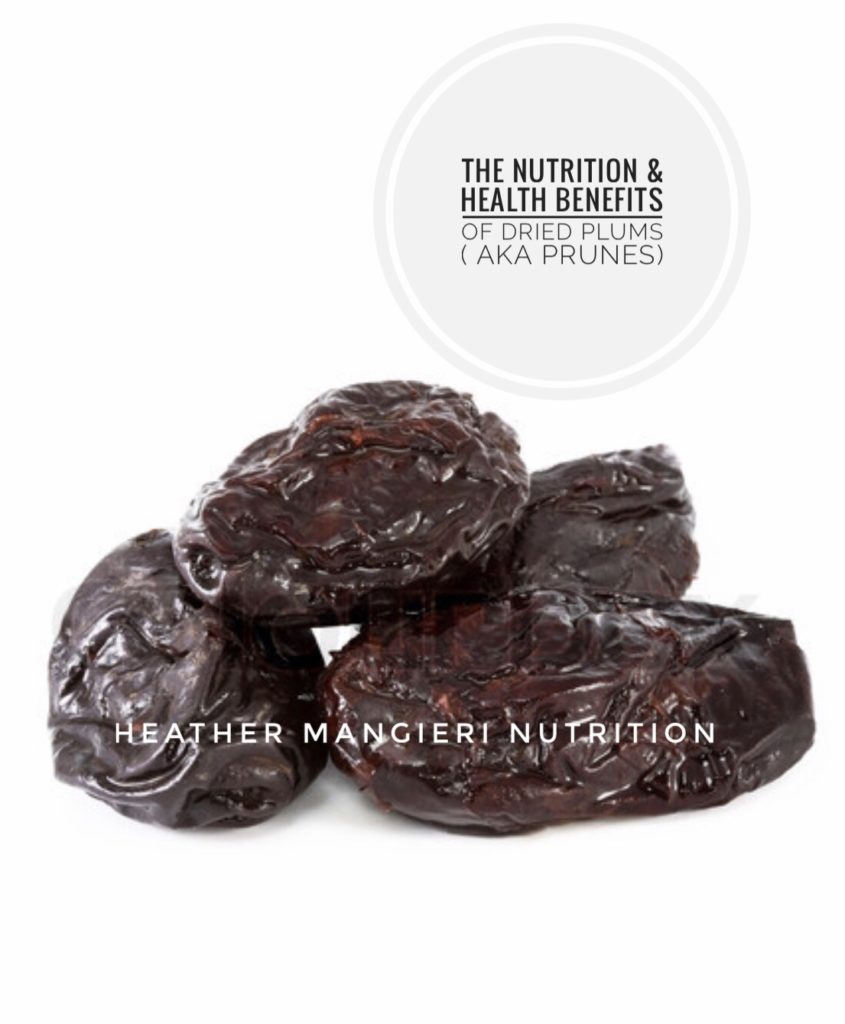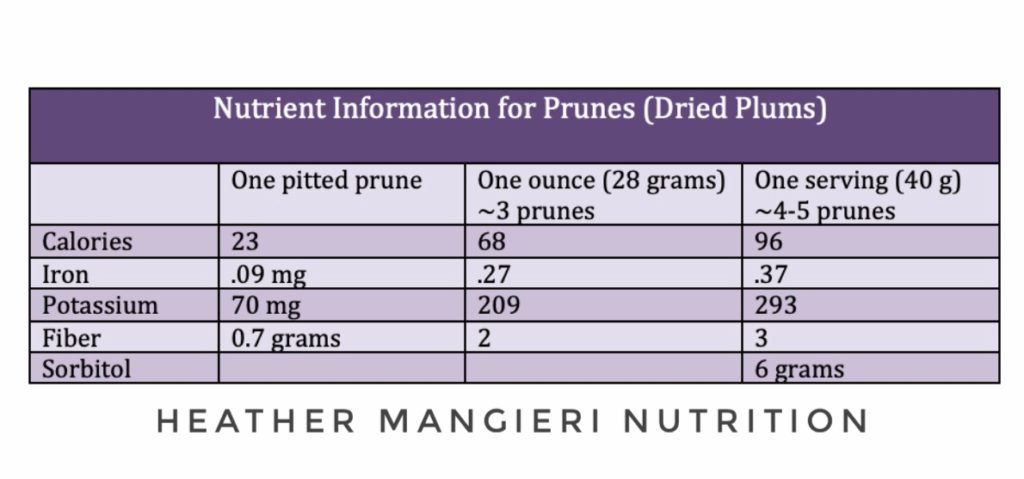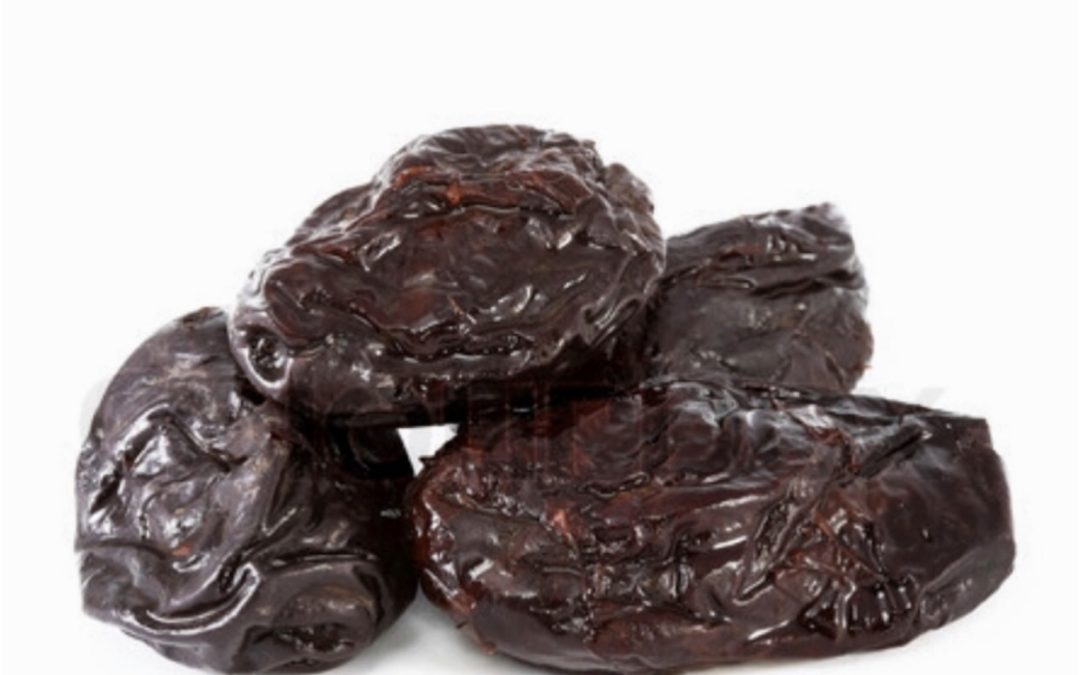Prunes, AKA dried plums, are an affordable, portable and nutritous fruit that is available year round. This post shares how they support GI health, bone health and the other nutrition and health benefits they offer. Plus, delicious ways to eat them.
What’s the first thing you think of when someone says prunes? If it’s constipation, you’re not alone. Prunes have a reputation for promoting a healthy gastrointestinal tract and are commonly prescribed to infants and older adults as a way to stimulate a bowel movement. But, prunes have much more to offer than just a trip to the bathroom.
The wrinkled skinned fruit is filled with fabulousness, not only for its health promoting benefits, but also as an ingredient in many dishes. That’s why they’ve decided to sharpen up their image with a new name. Get ready everyone…. prunes are making a comeback. Introducing the Dried Plum!
 Is it a Plum or a Prune?
Is it a Plum or a Prune?
All prunes are plums but not the ones that you may be thinking of. Plums that are specifically grown to be dried are a different variety from the fruit you find at your local farmers market. The variety used for dried plums are oblong in shape and are higher in sugar content. After harvest, they are dehydrated, rehydrated then packaged to be sent to grocery stores for purchase.
The Natural Laxative for GI Health
According to the National Institute of health, 60-70 million Americans are affected by digestive diseases, with $725 million dollars spent annually on laxatives. Wow! (Are you starting to see why the world needs dried plums?)
Dried plums have a unique combination of soluble and insoluble fiber. Most of what you’ll read credits fiber for the laxative properties. The insoluble fiber in dried prunes adds bulk and pulls water into the intestine resulting in softer stool that can be more quickly eliminated. Soluble fiber mixes with water in the stomach to become more viscous. This can help delay stomach emptying, giving a feeling of fullness and satiety. That’s a win-win for not only weight maintenance, but along to promote a healthy GI system.
But there’s actually more to the story. Dried plums have two other compounds, sorbitol and phenolic acids, which may also play a role in their laxative effect. The first compound, sorbitol is a sugar alcohol which the human body metabolizes slower than sugar. Sorbitol puts forth its laxative effect by drawing water into the large intestine, thus stimulating bowel movements.
Sorbitol is considered safe, but as with most things, consuming too much is not necessarily better. Ingesting large quantities of sorbitol (or other sugar alcohols) may result in unwanted side effects such as gas, abdominal discomfort and diarrhea.
Research has also looked at the use of prune juice as a remedy for constipation. One study suggested that drinking 8 ounces of prune juice daily is as likely as psyllium (Metamucil) to provide immediate relief of constipation symptoms. Since prune juice lacks the fiber that dried plums have (unless it has the pulp), there must be something else behind that laxative effect. More research is needed before we can say for sure, but in the meantime, if you have constipation, it’s worth a shot.
Prunes For Bone Health
As a sports dietitian that works with young athletes, I spend a lot of time talking about bones. My teens are not interested in how their bones will look in 40 years, but they’re ears open when I explain that bone injuries are among the most common sports-related injuries in athletes. And, an injured athlete is not going to perform their best.
I know that a critical time to focus on building strong bones is during the adoelscent years. That’s becasue 90% of bone mass is obtained by age 18 in girls and age 20 in boys. I don’t know about you, but if I want to get my kids eating prunes, I better have a delicious way to serve them!
Prunes have the vitamins, minerals, boron, copper and potassium, which are all bone supporting nutrients. So, while eating 4-6 prunes a day isn’t even close to a guarantee that you’ll have strong bones, it certainly can’t hurt to incorporate them into your healthy eating plan.
The Nutritional of Dried Plums (Prunes)
Dried plums are a good source of potassium, soluble and insoluble fiber and phytochemicals. They also have some iron and vitamin A. When you’re looking for key nutrients, be careful to evaluate the portion size. Some information out that boasting the benefits of dried plums list the portion size as 1 cup. One cup is a LOT of dried plums – over 400 calories worth, in fact. More reasonable daily intakes are below as a comparison:

Dried plums are affordable, portable (think gym bag), and available year round. Keep your GI tract healthy and flavor your food by incorporating this dried fruit into your daily diet.
Ways to Enjoy Dried Plums
- Use it as a fat substitute in cooking. Make prune puree by combining 8 ounces (~ 1 1/3 cup) pitted prunes and 6 tablespoons hot water in a food processor. Pulse off and on until smooth. Store in an airtight container for up to 2 months.
- Dice dried plums and mix into hot or cold cereal, yogurt or cottage cheese.
- Make a trail mix. Dice a few dried plums and mix with dried cereal, almonds, sunflower seeds and chocolate chips for a crunchy sweet and salty snack
- Use dried plums in place of other dried fruit in your favorite granola or energy bar recipe
- Add to salads, stuffing or stews.
- Create a sauce. Pureed prunes mix great with other flavors. Try this homemade barbeque sauce.
- Create a spread to top crackers or add flavor to bagels, wraps and sandwiches. Try this dried plum and cream cheese spread from the California Dried Plum Board.
- Eat them plain. Dried plums are naturally sweet so having one after dinner can satisfy your sweet tooth.
For more nutrition information, health benefits and recipes, check out the California Prunes website.
Do you eat dried plums as part of your healthy lifestyle? Share your favorite way to incorporate them into your diet in the comments below.


 Hi, I’m Heather – a registered dietitian, busy mom, consultant, adventure junkie and travel addict who has mastered living healthy on the go. My blog is where I share simple recipes and healthy living tips to help and inspire others to live their best life.
Hi, I’m Heather – a registered dietitian, busy mom, consultant, adventure junkie and travel addict who has mastered living healthy on the go. My blog is where I share simple recipes and healthy living tips to help and inspire others to live their best life.
Please how can I get some in Ghana